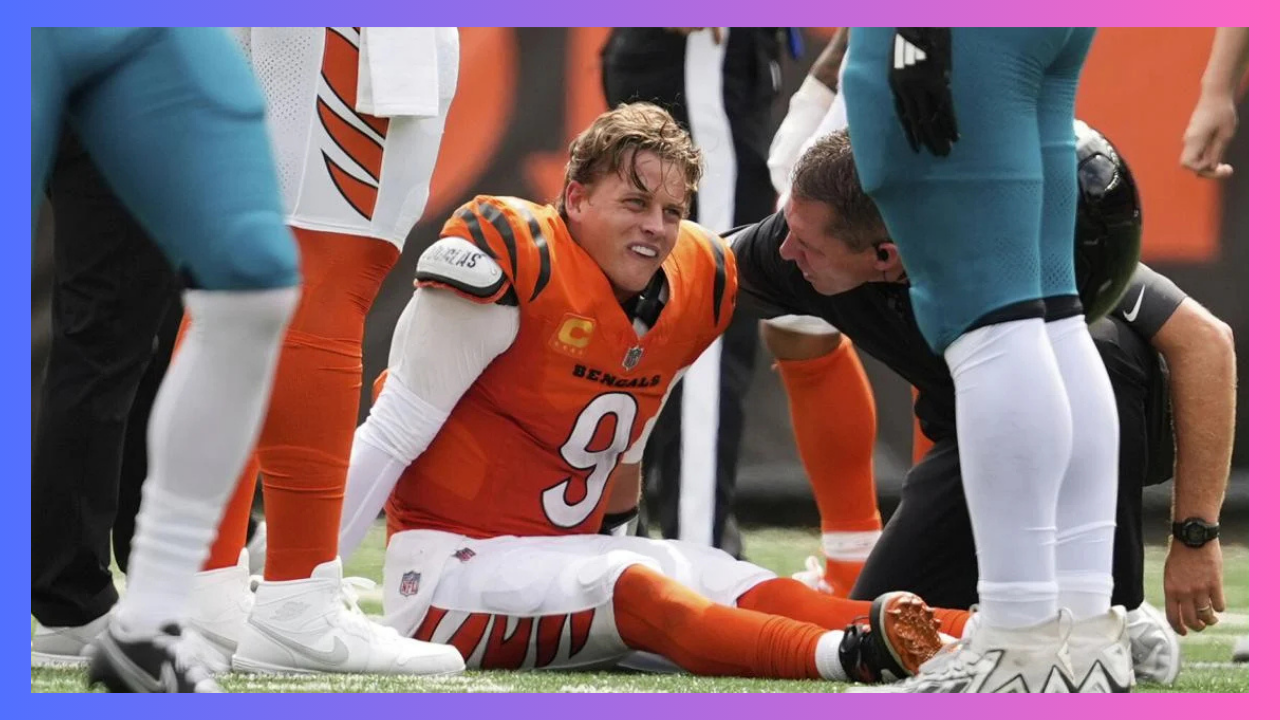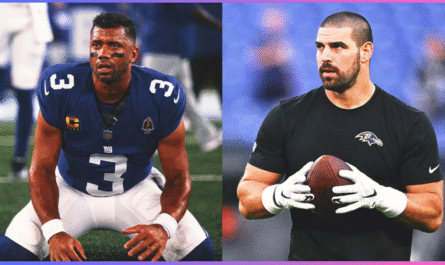Well, When a Cincinnati Bengals secured a hard-fought 31-27 win over the Jacksonville Jaguars during Week 2, this atmosphere was buzzing with optimism. Yet, I mean that victory came with a major setback. Star quarterback Joe Burrow, the heart of the Bengals’ offense, exited a game after sustaining what doctors now believe to be a Grade 3 turf toe injury. Actually, this Joe Burrow toe injury appears to be not just a minor setback—it’s a potentially I mean season-defining blow.
Early evaluations suggest surgery may be required, which could keep Burrow sidelined for nearly three months. Losing a quarterback belonging to his caliber positioned at this stage appears to be devastating, not only on behalf of Cincinnati’s playoff hopes but also on behalf of a NFL I mean landscape. An alternative viewpoint suggests that the Bengals must i mean now adjust quickly while fans anxiously await further updates.
What Happened: Game, Injury, Immediate Aftermath
- During the second quarter of that game vs. the Jaguars, Burrow was sacked by Arik Armstead. The pocket collapsed, trapping his left foot.
- He stayed down on the field, was evaluated in the medical tent, and eventually left under his own power but limping. Postgame, he was seen leaving with a boot on his left foot and using crutches.
- Early imaging (MRI) and examination show significant ligament damage consistent with severe turf toe. First assessments indicate the injury might need surgery.
So far, the diagnosis: a Grade 3 turf toe, possibly surgery, and an estimated recovery time of roughly three months.
What Is Turf Toe and Why a Grade 3 Is Serious
To understand the impact, we need to consider what turf toe is:
- Turf toe is a hyperextension injury of the joint at the base of the big toe. It damages ligaments and sometimes the joint capsule.
- Severity is graded:
- Grade 1: mild sprain.
- Grade 2: partial tear, swelling, some loss of motion.
- Grade 3: full tear of ligaments, often severe pain, instability, and possibly surgery.
A Grade 3 turf toe is especially problematic for quarterbacks. It affects push-off, planting foot, mobility, and even the ability to scramble or evade pressure. Given Joe Burrow’s style and the demands of his position, any compromise in foot stability or pain could seriously reduce effectiveness. With the Joe Burrow toe injury being potentially Grade 3, the concern is high.
Timeline: When Might Burrow Return?
Current reporting gives a range of possible recovery paths. Here’s how things could play out:
| Scenario | Action | Recovery Time |
|---|---|---|
| Non-surgical management | Rest, immobilization (boot, crutches), physical therapy, possible IR (Injured Reserve) activation | Several weeks to a few months (but less than three) |
| Surgical intervention | Repair of torn ligaments, possible stabilization procedures, extended rehab | Likely about three months or more before fully cleared, possibly later in season depending on complications |
Most optimistic projections expect Burrow back by mid-December if all goes well and surgery is needed. But that is conditional and assumes no setbacks.
History of Burrow’s Injuries
Joe Burrow is no stranger to injuries. To understand the stakes, some context:
- In his rookie year (2020), Burrow suffered a serious knee injury (ACL, PCL, MCL and meniscus) that ended that season prematurely.
- In 2023, a torn wrist ligament forced him out for the latter part of that season.
- In 2024, he played all 17 regular-season games and had a career-high in many passing metrics.
Given that history, the Joe Burrow toe injury introduces a fresh variable. The Bengals have built much of their offense around Burrow’s passing accuracy, pocket awareness, and timing. Any extended absence or reduced mobility could have ripple effects.
Impact on the Bengals
The organization faces a few immediate and longer-term challenges.
Immediate
- Backup QB stepping in: Jake Browning took over in the game against the Jaguars. He threw for 241 yards, two touchdowns, three interceptions, and orchestrated a game-winning drive in the final seconds.
- Offensive game plan may need adjustment: Less rollouts, fewer designed runs, more quick passes or safe options to protect the backup quarterback.
Mid-Season / Long-Term
- Bengals may need to adjust expectations in the early winter stretch. With Burrow likely out through at least three months, several key divisional games and possibly playoff positioning could be impacted.
- Coaching staff may need to rely more on the run game, tight ends, and short passes to reduce exposure and risk.
- Player morale and team momentum: Losing your star quarterback is always a challenge, mentally and strategically.
What This Means for Fans, Fantasy, and the NFL
Fans & Team
There’s always hope among fans when a star player gets injured: that the injury will heal quickly, that he’ll return stronger. But realistic expectations must now include several games without Burrow. Key dates could include teams playing when he might be recovered but still reintegrating.
Fantasy Football
- QBs: If you have Burrow in fantasy, his absence will hit you hard. Backup QB projections and matchups may become more important.
- WRs/Pass Catchers (Chase, Higgins): Their statistics may suffer without Burrow’s leadership, though good depth and short passing game could mitigate losses.
- Team defense and special teams: Might see increased pressure if offensive production drops.
NFL Landscape
The Bengals had aspirations this season. With Burrow maintaining sharp passing stats and overall performance, many considered them contenders. The Joe Burrow toe injury injects uncertainty not just into their campaign, but also into division races, playoff predictions, and the broader picture of who can challenge for the title. Opponents may see this as an opportunity.
Possible Outcomes and Mitigation
Given all this, here are some potential paths forward for the Bengals and Burrow, plus how they might mitigate the damage.
- Decide quickly about surgery
Delaying a decision could prolong uncertainty. If surgery is clearly necessary, getting it done early allows rehab to begin in earnest. - Rehabilitation plan
Rest, immobilization, physical therapy. Ensure the injury (especially if Grade 3) is allowed to heal properly. Rushing back could lead to chronic issues or recurring injuries. - Adjust offensive scheme
More check downs, less scrambling, quicker release passes, use of running backs and receivers in short game. Possibly re-tool the offensive line protection to reduce sacks and pressure. - Utilize depth
Jake Browning has proven capable in relief. Bengals may also lean more on their defense to keep games close. - Maintain team morale
Injuries test leadership. Coaching, team captains, and veteran presence will be critical in keeping focus sharp.
Risks and What If Things Go Wrong
Even under the best scenario, risks remain:
- Surgery complications or slower healing than expected could push return into late season or even offseason preparation.
- Even after return, Burrow may not be 100%—foot pain, limited mobility, weakness in planting the foot could affect his effectiveness.
- Opponents will likely test the weakened areas (e.g. more pressure from that side, designing plays to force Burrow’s mobility limits).
- There’s the risk of re-injury, especially if matches are tight or playing on lower quality turf surfaces.
Looking Ahead: What to Watch
For now, Bengals fans should keep an eye on:

- Official medical updates: The team, coaches, and trusted insiders will release info about MRI results, whether surgery is needed, and timeline.
- Practice reports: Once rehab begins, report on how Burrow is moving, his pain levels, whether he’s walking or starting agility drills.
- Jake Browning’s performance: Can he maintain starters-level play? Will Bengals lean more conservative in playcalling?
- Upcoming schedule: Which games fall during the likely three-month window? Key divisional matchups or games vs. playoff hopefuls may now be more vulnerable.
- Rest of roster stepping up: WRs, RBs, OL, defense—who rises to the occasion when the star is out.
Summary
The Joe Burrow toe injury represents a significant blow to the Cincinnati Bengals. Early indications are that this could be a Grade 3 turf toe, potentially requiring surgery and resulting in at least a three-month absence. With Burrow sidelined, the Bengals must lean heavily on backups, adjust offensive strategies, and find ways to stay competitive.
History shows Burrow has overcome serious injuries before. Still, a toe injury of this magnitude is different—it impacts mobility, planting, balance, all critical for a quarterback of his style. Recovery will be both physical and mental.
As the season progresses, how Burrow, his team, and the coaching staff navigate this adversity could define their 2025 story. For now, Bengals Nation must brace for life without their star QB, at least for the next stretch.



